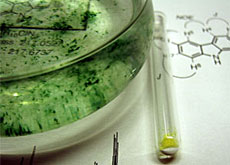
Pond scum shows promise against Alzheimer’s

Swiss researchers have isolated a compound from blue-green algae that could become a drug candidate against Alzheimer's disease and other brain afflictions.
But the scientists warn it could be years and plenty of money before any potential application appears on the drug market.
It is believed to be the first time that a potent agent against Alzheimer’s has been extracted from a type of cyanobacteria commonly known as ‘pond scum.’
The new compound, nostocarboline, was isolated by scientists at the Federal Institute of Technology in Zurich, as well as Zurich and Lausanne universities from a type of blue-green algae known as Nostoc.
Laboratory tests showed that it was to be a potent inhibitor of cholinesterase – a brain chemical that has been associated with the progression of Alzheimer’s.
Cholinesterase breaks down another chemical, acetylcholine, which is used by the brain to help process and store information.
While there is no known cure, cholinesterase inhibitors have shown promise for delaying or preventing the symptoms of mild to moderate forms of the disease.
The researchers led by Karl Gademann and Friedrich Jüttner said the compound’s effects are comparable to galanthamine, a cholinesterase inhibitor already approved for the treatment of Alzheimer’s.
Finding substances in bacteria to fight diseases is not uncommon. They are already widely used in medicines such as antibiotics.
For this discovery, the scientists extracted and tested hundreds of substances. Gademann’s lab specialises in identifying bioactive compounds from natural sources.
Cyanobacteria and other marine natural products are considered a prime source for drug candidates against human diseases, including cancer and bacterial infections. But so far very little is known about their chemistry.
Basic research
The researchers warn that despite the promise shown by the new substance, there’s no way it will be appearing in pharmacies anytime soon according to Gademann.
“This is basic research,” he told swissinfo. “We are at the very beginning of any potential development.”
He warns that it could take years before a drug candidate is even tested on humans. To get that far, he adds that a pharmaceutical company would have to be involved to move the research further on.
“We would still have to test the compound on mice, then on primates before considering human trials,” said Gademann. “And even then, we can’t be sure what the side-effects might be.”
Another issue that has to be tackled is dosage. The scientists say they have to find out whether too little or too much of the substance prevents or triggers Alzheimer’s.
They feel though that it shows enough promise to have had it patented. In fact, nostocarboline could be used as a herbicide say the researchers.
The Nostoc algae produce the compound to protect themselves against insects and small crabs that eat them, as well other algae. It could be used against the proliferation of some types of marine algae, with the added advantage of being cheap and easy to produce.
The Swiss researchers’ results were published in the latest edition of the Journal of Natural Products.
swissinfo with agencies
More than 24 million people around the world suffer from Alzheimer’s disease and related afflictions.
This number is expected to double in the next 20 years, with a new case every seven seconds according to a recent study published in the Lancet medical review.
In Switzerland, around 90,000 people suffer from some form of brain degeneresence.
Aloïs Alzheimer first described the disease named after him in 1907.
Brain cells are slowly destroyed, leading to a decline in mental faculties.
Typical symptoms are memory loss and disorientation.
Elderly people are the first victims of Alzheimer’s, with 8% of the over-65s suffering from the disease.
But there is also early form (10% of cases) that afflicts 30- to 50-year-olds.
There is still no explanation as to what triggers the disease.

In compliance with the JTI standards
More: SWI swissinfo.ch certified by the Journalism Trust Initiative




























You can find an overview of ongoing debates with our journalists here . Please join us!
If you want to start a conversation about a topic raised in this article or want to report factual errors, email us at english@swissinfo.ch.